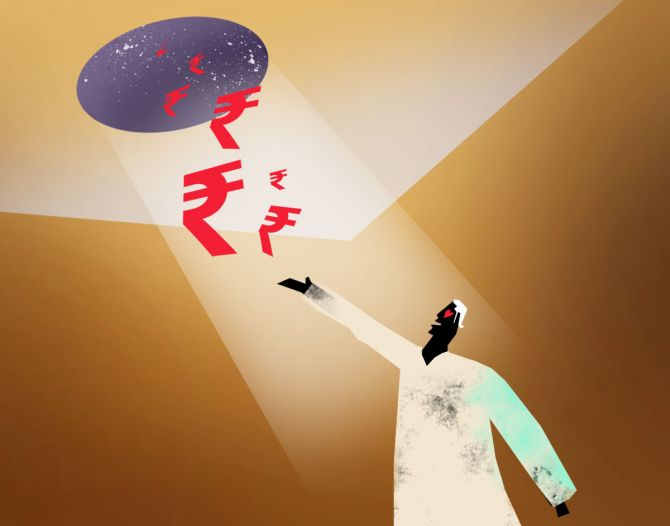In the June quarter of FY24, 51 per cent of consumers who took small-ticket personal loans already had more than four credit products at the time of accessing yet another new loan, compared with just 17 per cent in the June quarter of FY20, points out Tamal Bandyopadhyay.

Finally, it happened. Even though the heads of public-sector banks (PSBs) have not been losing sleep over unsecured small loans turning bad since they form a minuscule part of their overall credit book, the Reserve Bank of India doesn't want to take a chance.
Last fortnight, the RBI raised the risk weight for consumer loans, barring housing, education, vehicle and gold loans, and loans given to microfinance entities and self-help groups by banks and non-banking financial companies (NBFCs) by 25 percentage points.
This will increase the cost of capital for such loans for lenders and discourage them from going overboard.
Earlier, in the October monetary policy statement, while emphasising the importance of financial sector stability, RBI Governor Shaktikanta Das spoke about the very high growth of certain components of personal loans.
The RBI has been closely monitoring them for any signs of incipient stress.
'Banks and NBFCs would be well-advised to strengthen their internal surveillance mechanisms, address the build-up of risks, if any, and institute suitable safeguards in their own interest,' Das said, adding, 'The need of the hour is robust risk management and stronger underwriting standards.'
Deputy Governor Swaminathan J, too, pointed out that unsecured loans have been an 'outlier', growing at 23 per cent in the past two years, while other segments such as loans to corporations and small and medium enterprises have been growing at 12 to 14 per cent.
Amid growing concerns over the ability of small borrowers to service loans, the finance ministry had asked the PSBs to review their small loan portfolios and submit a report on the state of affairs in this segment.
The bankers have assured the ministry that they do not see any systemic risks emanating from small unsecured loans as their overall exposure remains tiny.
The risk weight is an instrument, often used by the banking regulator, to rein in lenders' over-enthusiasm in giving certain types of loans.
For instance, when rising exposure to the real estate sector created concerns about asset quality and the potential systemic risks, the risk weight on banks' exposure to commercial real estate was increased from 100 per cent to 125 per cent in July 2005 and further to 150 per cent in April 2006.
Before that, the risk weight on housing loans was increased from 50 per cent to 75 per cent in December 2004.
This was done by then RBI Governor Y V Reddy. He also increased the risk weight for consumer credit and banks' capital market exposures from 100 per cent to 125 per cent.
According to the RBI's latest Financial Stability Report, released in June, advances for unsecured retail loans rose to 25.2 per cent in March 2023 from 22.9 per cent in March 2021, while secured loans saw a decline to 74.8 per cent from 77.1 per cent during the same period.
Overall, retail loans grew at a compound annual growth rate, or CAGR, of 24.8 per cent from March 2021 to March 2023 in contrast to 13.8 per cent CAGR for overall bank credit.
Ahead of that, an RBI publication titled Report on Trends and Progress of Banking in India in December 2022 warned that retail loans could become a 'systemic risk'.
'In recent years, Indian banks appear to have displayed 'herding behaviour' in diverting lending away from the industrial sector towards retail loans.
'The decline was evident across bank groups. Empirical evidence suggests that a build-up of concentration in retail loans may become a source of systemic risk,' the report observed.
Let's take a closer look.
Delinquencies, measured in terms of the inability of borrowers to repay loans between 31 and 180 days, for loans under Rs 50,000 rose to 8.1 per cent in June 2023, credit bureau CRIF Highmark's data show.
Technically, a loan turns into special mention account 1 (SMA-1) if the borrower has not paid the repayment instalment within 30 days; SMA-2 for non-payment over 60 days; and a non-performing asset (NPA) when the repayment is not done even after 90 days.
Essentially, loans belonging to the SMA-1 and SMA-2 have been growing.
The bad loans in the retail segment were 1.4 per cent as of March 2023.
Going by the CRIF Highmark data, the total value of short-term personal loans (STPL) below Rs 10,000 grew 37 per cent in the financial year ending March 31, 2023, while STPL of Rs 10,000 to Rs 50,000 rose 48 per cent.
The credit bureau considers loans up to Rs 50,000 as STPL.
Some 8.6 million such loans were disbursed in FY23, registering a 50 per cent rise over FY22.
About 80 per cent of all personal loans disbursed in FY23 were STPL and 60 per cent of such loans had an ultra-small ticket size -- below Rs 10,000.
The overall personal loan portfolio was to the tune of Rs 11.16 trillion as of June 2023 -- more than double of the level seen in March 2020 (pre-Covid).
Small cities are contributing more to these loans.
About 38 per cent of STPL up to Rs 10,000 in the last 12 months were outside India's top 100 cities. In contrast, 29 per cent originated in the top eight cities.
To support the fact that small cities are playing a bigger role in this segment, the credit bureau says 35 per cent of STPL between Rs 10,000 and Rs 50,000 sanctioned between July 2022 and June 2023 were from beyond the top 100 cities, while the top eight cities accounted for 31 per cent.
NBFCs dominate the origination and the portfolio of such loans. The share of private banks by origination volume has risen from the pre-Covid level, but relative to March 2022, it has dipped.
An October report of Swiss brokerage UBS red-flagged the issue, saying the PSBs may see higher defaults than their private peers, as credit losses from unsecured retail loans could increase 50-200 basis points in 2024-2025.
One basis point is a hundredth of a percentage point.
'State-owned banks likely had 52 per cent of their outstanding personal loans to borrowers with credit scores below 644 (medium- to high-risk borrowers), while NBFCs had 49 per cent and large private banks about 31 per cent in June 2023,' the report pointed out.
Finally, the phenomenon of over-leveraging.
A November 2 report of credit bureau TransUnion CIBIL discusses how the profile and preferences of borrowers have been changing -- more consumers seeking multiple credit products within a short time span.
Its Credit Market Indicator report for the quarter ending June 2023 talks about a healthy retail credit growth and broadly stable delinquency level even as a few pockets are showing signs of risk build-up.
Stress is seen on credit cards and personal loans.
Since January 2022, small-ticket personal loans of less than Rs 50,000, while representing a very small share of total retail balances, have roughly accounted for one-fourth of total volumes.
In the June quarter of FY24, 51 per cent of consumers who took small-ticket personal loans already had more than four credit products at the time of accessing yet another new loan, compared with just 17 per cent in the June quarter of FY20.
There are other signs that reveal all is not hunky-dory.
A recent study by SBI Life Insurance, in collaboration with Deloitte, finds that 47 per cent of individuals surrendered their life insurance policies in the last five years.
Meanwhile, the absolute number of income tax returns filers is rising, but the number of taxpayers is going down.
Whether we like it or not, clearly there is stress in the space of unsecured borrowers.
Who is responsible for the over-leveraging? NBFCs? Fintechs? Where do they get the money to lend?
The RBI has not kept its eyes closed to the warning signals of stress that built up. Rightly so.
But I am just curious about the timing of the action.
Swaminathan ruled out any regulatory prescription such as an increase in risk weight last month.
'We would expect banks, NBFCs and fintechs to act as a first line of defence,' he said.
Probably, the September quarter data (not available to the public yet) has shown further rise in personal loans and delinquencies.
Tamal Bandyopadhyay, author of Roller Coaster: An Affair with Banking, is a senior advisor to the Jana Small Finance Bank Ltd.
Feature Presentation: Aslam Hunani/Rediff.com










